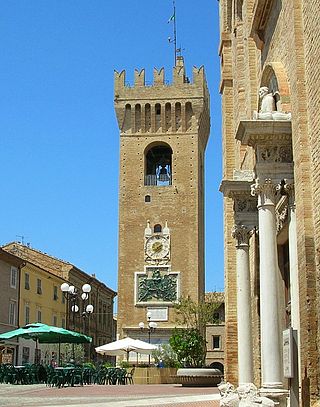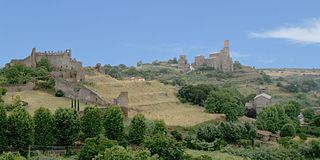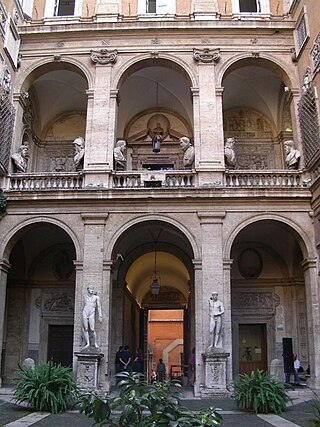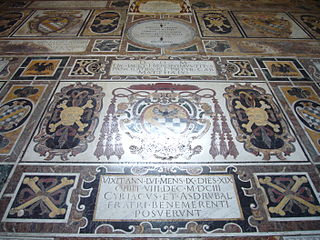
The House of Orsini is an Italian noble family that was one of the most influential princely families in medieval Italy and Renaissance Rome. Members of the Orsini family include five popes: Stephen II (752–757), Paul I (757–767), Celestine III (1191–1198), Nicholas III (1277–1280), and Benedict XIII (1724–1730). The family also included 34 cardinals, numerous condottieri, and other significant political and religious figures. The Orsini are part of the Black nobility who were Roman aristocratic families who supported the Popes in the governance of the Papal States.

Bracciano is a small town in the Italian region of Lazio, 30 kilometres northwest of Rome. The town is famous for its volcanic lake and for a particularly well-preserved medieval castle Castello Orsini-Odescalchi. The lake is widely used for sailing and is popular with tourists; the castle has hosted a number of events, especially weddings of actors and singers.

Forlimpopoli is a town and comune in the province of Forlì-Cesena, north-eastern Italy. It is located on the Via Emilia between Cesena and Forlì.

The papal conclave that followed the death of Pius VI on 29 August 1799 lasted from 30 November 1799 to 14 March 1800 and led to the selection of Cardinal Barnaba Chiaramonti, who took the name Pius VII. This conclave was held in Venice and was the last to take place outside Rome. This period was marked by uncertainty for the papacy and the Roman Catholic Church following the invasion of the Papal States and abduction of Pius VI under the French Directory.

Recanati is a comune (municipality) in the province of Macerata, in the Italian region of Marche. Recanati was founded around 1150 AD from three pre-existing castles. In 1290 it proclaimed itself an independent republic and, in the 15th century, was famous for its international fair. In March 1798 it was conquered by Napoleon.

Vetralla is a town and comune in the province of Viterbo, in central Italy, 11 kilometres (7 mi) south of that city, located on a shoulder of Monte Fogliano.

Tuscania is a town and comune in the province of Viterbo, Lazio Region, Italy. Until the late 19th century the town was known as Toscanella.

The Palazzo Mattei di Giove is the most prominent among a group of Mattei houses that forms the insula Mattei in Rome, Italy, a block of buildings of many epochs.

Ponderano is a municipality in the province of Biella, Piedmont, northwestern Italy. Neighbouring comuni include Borriana, Gaglianico, Mongrando, Occhieppo Inferiore and Sandigliano.
Bassano Romano is a town and comune situated in the hills of Monti Sabatini in the province of Viterbo, in northern Lazio (Italy). With its origins about 1000 as the agricultural hamlet of Bassano di Sutri the village's future was founded in 1160 by the wealthy landowner Enotrio Serco, who initiated the construction at the top of the slope of a fortified residence that over the centuries became a princely dwelling, frescoed by famous artists. In 1482 Pope Sixtus IV assigned the Foedus Bassani to the Anguillara, Roman patricians . The growth of the comune redoubled after 1565, when the signory was reassigned by Pope Clement VIII to the Giustiniani, merchants of Genoese origin settled at Rome. In 1605 the signory was raised to a marquessate: a hunting lodge called "La Rocca", granaries, a stone bridge and the church dedicated to San Vincenzo were all constructed. During the Giustiniani residence, artists were commissioned to carry out frescoes: Francesco Albani, Domenico Zampieri "Domenichino" and Antonio Tempesta are all represented. In 1644, a bulla of Pope Innocent X made the marchese of Bassano a prince, and the flock of papal and noble visitors included James Stuart, pretender to the thrones of England and Scotland. In 1735, under Giustiniani patronage the maiolica manufactory of Bartolomeo Terchi was transferred here from Siena.

Campo di Giove is a town and comune in the province of L'Aquila in the Abruzzo region of central Italy. Its territory is included in the Majella National Park. Located at the foot of the southwestern slope of the Majella, it is a holiday resort in summer and winter, thanks to the presence of a ski station. In English, its name means 'Campus Jovis'.

The House of Mattei was one of the most powerful noble families of Rome during the Middle Ages and early modern era, holding high positions in the papal curia and government office. The family amassed significant art collections under art enthusiasts such as Ciriaco Mattei.

Castiglione in Teverina is a comune (municipality) in the Province of Viterbo in the Italian region Lazio, located about 90 kilometres (56 mi) northwest of Rome and about 25 kilometres (16 mi) northeast of Viterbo.
Guarcino is a comune (municipality) in the Province of Frosinone in the Italian region Lazio, located about 70 kilometres (43 mi) east of Rome and about 20 kilometres (12 mi) north of Frosinone in the Monti Ernici area.
Ciriaco Mattei was an Italian nobleman of Rome and of the House of Mattei and one of the most prolific art collectors of his time.

Girolamo Mattei was an Italian Cardinal from the House of Mattei.

Luigi Mattei was an Italian military General and Marquis de Belmonte. During the 17th century he commanded troops loyal to the papal armies of Barberini Pope Urban VIII and Pamphili Pope Innocent X during the Wars of Castro.
Girolamo Mattei was an Italian nobleman of the House of Mattei and Duke of Giove.

Asdrubale Mattei, Duca di Giove, was an Italian nobleman of the House of Mattei, an avid art collector and a patron of Caravaggio.

Civita Castellana is a town and comune in the province of Viterbo, 65 kilometres (40 mi) north of Rome.




















